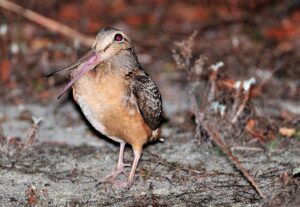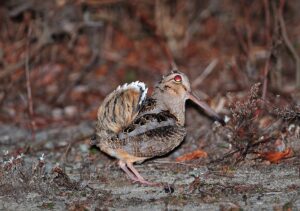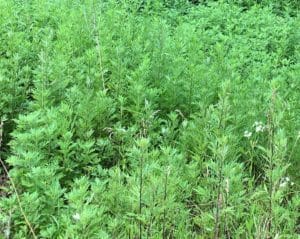Hello fellow readers, What fun to witness the mating dance of an American Woodcock invited by my birder buddy Dennis Briede of Blairstown, NJ. Mic in hand, I captured his unusually loud, nasally insect-like sound while the male was on the ground, followed by a melodic call while swooping through the air. (Enjoy hearing the sounds and story on the Podcast – link below.)

Woodcock in Full Peent – Photo by Blaine Rothauser
How the Woodcock swooped quickly from side to side in song with his light underbelly glowing in the dusk intrigued me the most. It reminds me of a bat feeding while flitting through the night sky. His charming appearance is alluring— big beaked, big eyes high on his head, and a body about robin-sized but shaped like a football.
The Woodcock’s plumage blends into the foliage, and their shy demeanor makes them hard to see other than at dusk and dawn during mating season when the males show off for the ladies with their loud peent calls and aerial acrobats. Boys will be boys (smile).
Dennis explained they’re considered a shorebird though they breed inland. Last summer, Jolee got on a scent near Blue Mountain Lake. I followed her and saw what I now know was a docile and adorable Woodcock. They nest near wet spots or marshes; why the little fellow chose the underbrush near the lake.
How to Make a Meadow

Woodcock Mating Dance – Photo by Blaine Rothauser
Before visiting Dennis, I drafted a story about starting a meadow, and I thought he could share a few tips. As it turns out, his meadow was there when he bought the property almost 18 years ago. He enhanced it by removing invasive plants and keeping volunteer woody plants in check. But Dennis shared the NJ Land Conservancy’s protocol to convert a field now inundated with Mugwort into a meadow in the South Branch Preserve in Mt Olive, NJ.
Chrysanthemum-looking plumy colonies of invasive Mugwort (Artemisia vulgaris) are also known as Common Wormwood; even the name sounds nasty. Their aggressive underground stems, called rhizomes, send out roots and shoots that travel two feet below the surface, making it a miserable invader to squelch.

A colony of invasive Mugwort
Squelching Mugwort Organically
I hadn’t known the benefits of using Mugwort as an insect repellent by crushing the stems and applying the juice. But the over-your-head high two-acre patch is more repellent than anyone can use.
Dennis described the several-year remedy underway that an organic farmer shared that could work to develop a meadow even if Mugwort is not your dilemma.
First, mow the field low, maybe two inches, three inches, for the whole year, so nothing goes to seed. Then the following year, keep tilling it.
“I know they don’t like you to till, but I don’t think there’s any other way when not using chemicals,” Dennis said.
Keep turning it over when the field is about eight inches, leaving the foliage on the surface. Then in the early Fall, plant farm peas to add nitrogen to the soil. It also blocks whatever else is trying to grow during the last two months of the growing season.
“We’ll till again this spring and plant buckwheat with very large leaves and shades everything over. You have to cut it down before it goes to seed, about early July,” Dennis said. He plans to till the buckwheat under one or two more times. Then plant wildflower seeds in the Fall with short grasses no more than three feet high (like Little Bluestem Schizachyrium scoparium).
“We don’t want the tall ones because they’ll compete with everything. The whole thing takes five years to look nice. Then we plan to mow half the meadow yearly to keep woody plants at bay.”

Beautifully Beaked Woodcock – Photo by Blaine Rothauser
The Population Decline of the Woodcock
So back to the beautifully beaked Woodcock, also called a Timberdoodle. It’s a popular gaming bird which makes me sad. I can appreciate hunting for food, but for gaming. Well, that’s what clay pigeons are for though some consider the charming bird a flavorful feast. The cocker spaniel breed of hunting dog is named after them.
Populations declined between 1966 and 2019, though hunting tallies decreased considerably from 1.5 million yearly in the 1970s to 170,000 in 2020. All About Birds writes the population decline may relate to habitat loss due to development and pesticides used to treat forest insects.
Plus, 60% of their food is earthworms, making Woodcocks vulnerable to contaminants in the soil. They also feed on flies, beetles, ants, snails, millipedes, spiders, and lesser amounts of plant material. They have a nifty way of rocking back and forth while feeding, likely to inspire critters underground to move to hear or feel the vibrations.
Mother Nature puts on a glorious dance. May more of us will learn to dance along with her, to nurture rather than disrupt and contaminate our dear earth.
Garden Dilemmas? AskMaryStone@gmail.com and your favorite Podcast App.
About Blaine Rothauser, Natural History Photographer, whose magnificent images are available to decorate your world.
There’s much more to the story in the Garden Dilemmas Podcast:
Link to the previous story about Dennis’s Antics of Meadow Wildlife
and Weeding Mugwort – Picking up Litter
The Cornell Lab All About Birds – American Woodcock Overview


